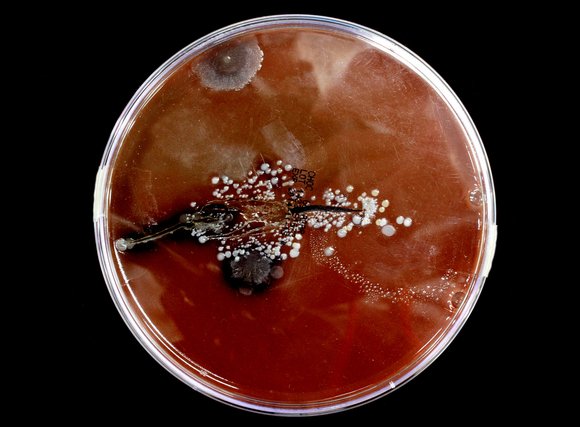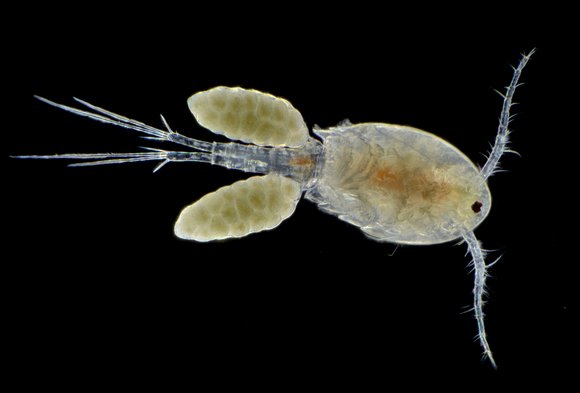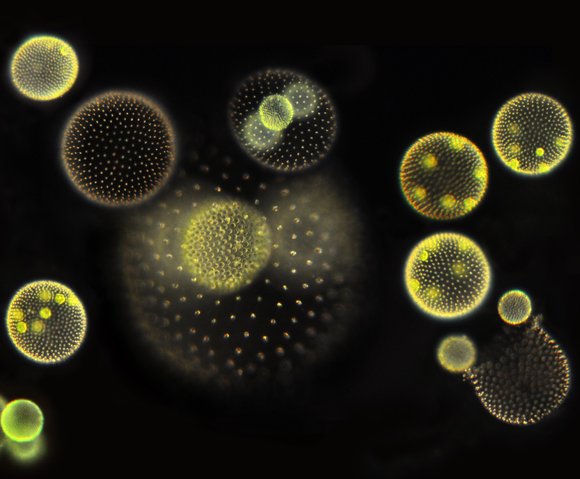No, it doesn't give me the creeps. In fact, I think it's fascinating that there are dozens of different kinds of bacteria, fungi and yeasts on the computer mouse or mobile phone that you're holding right now. And that, if you were now to drop it out of fright, there would still be a few million micro-organisms on your hand. And now don't go rubbing that antiseptic stuff all over it, because those micro-organisms actually protect you from infections. In addition, they make sure your skin is balanced and that it doesn't dry out.

A culture of the micro-organisms on a computer mouse in a petri dish. In Micropia you can see a complete wall full of petri dishes, and by means of time-lapse movies you can see how they grow.
The microbes on your skin, in your intestines and yes, even in your navel, don't need a lot of care. They live on nutrients that are available there or on other microbes in their environment. 'But what if you want to grow microbes in a lab? How does that work?' This is a common question at Micropia, but it is also frequently asked by my friends. For the sake of convenience, I compare it to a miniature zoo. All the microbes we cultivate grow as a result of proper care. For example, we provide an ideal temperature, make sure they receive the right food, and prevent them from getting overgrown by other, totally different microbes. Imagine not being able to see the penguins in a zoo because there's a bunch of zebras standing in front of them! Well, considering we have more than 300 kinds of microbes which we would like to display in the museum, you can imagine this care is quite a challenge.
When it comes to cultivation methods, our microbes can be roughly divided into three groups. There's the producers: the algae and cyanobacteria that are at the bottom of the food chain. These need light for photosynthesis and nutrients such as salts and minerals. The consumers feed on producers (or other consumers) and are sensitive to differences in acidity and temperature. And there’s the decomposers. These include fungi, yeasts and bacteria. Decomposers grow on agar plates with nutrients and are actually the gluttons of our miniature zoo.

The copepod (Cyclops strenuus) is a consumer you can see under the microscope in Micropia. This microbe lives in fresh surface water and eats other microbes.
And speaking of decomposers! Lately, a lot of hard work has gone into our newest exhibition: crucial cleaners . A giraffe calf, which died of natural causes at Artis, was decomposed by its own bacteria for ten months in a conditioned space, and is now displayed at Micropia. In this way, we also want to show visitors the decomposing function of microbes, and make them aware of how essential this microbial function is to life on earth. One of our colleagues at Artis wrote a story about the circle of life, especially for this exhibition. Will you come round to view the exhibition?
Partly because Micropia is an educational institute, we would like to offer interns opportunities to gain experience which they could not get anywhere else. Micropia is after all the world's only museum of microbes, which also makes its activities and responsibilities unique. Our interns are students at laboratory courses across the country. Eveline is from Veenendaal, for instance, and travels 1.5 hours to and from Micropia every day.

All the cells of a volvox are located on the outside of the sphere. Some have flagella (whip-like hairs) to help the colony move around and aother are responsible for reproduction.
She's currently working on optimising the growth of a number of species of algae, including Chlamydomonas, Gonium and Volvox. These algae grow well in our lab; in fact they grow too well. You can compare it to a plant in the garden which starts to grow out of control. Using the cell counter, which I wrote about in my first blog , we can measure the speed at which the alga grows (its division rate). By performing tests at different temperatures and/or lighting, we can influence the division rate. This also allows us to make the algae grow less quickly.
Unfortunately, I'm out of time. There’s still a great deal left to write, but it can wait till the next blog.
Best wishes, Ilja
